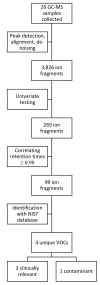Assessment of pulmonary oxygen toxicity in special operations forces divers under operational circumstances using exhaled breath analysis
- PMID: 32187611
- PMCID: PMC7276273
- DOI: 10.28920/dhm50.1.2-8
Assessment of pulmonary oxygen toxicity in special operations forces divers under operational circumstances using exhaled breath analysis
Abstract
Introduction: The Netherlands Maritime Special Operations Forces use closed circuit oxygen rebreathers (O₂-CCR), which can cause pulmonary oxygen toxicity (POT). Recent studies demonstrated that volatile organic compounds (VOCs) can be used to detect POT in laboratory conditions. It is unclear if similar VOCs can be identified outside the laboratory. This study hypothesised that similar VOCs can be identified after O₂-CCR diving in operational settings.
Methods: Scenario one: 4 h O₂-CCR dive to 3 metres' seawater (msw) with rested divers. Scenario two: 3 h O₂-CCR dive to 3 msw following a 5 day physically straining operational scenario. Exhaled breath samples were collected 30 min before and 30 min and 2 h after diving under field conditions and analysed using gas chromatography-mass spectrometry (GC-MS) to reconstruct VOCs, whose levels were tested longitudinally using a Kruskal-Wallis test.
Results: Eleven divers were included: four in scenario one and seven in scenario two. The 2 h post-dive sample could not be obtained in scenario two; therefore, 26 samples were collected. GC-MS analysis identified three relevant VOCs: cyclohexane, 2,4-dimethylhexane and 3-methylnonane. The intensities of 2,4-dimethylhexane and 3-methylnonane were significantly (P = 0.048 and P = 0.016, respectively) increased post-dive relative to baseline (range: 212-461%) in both scenarios. Cyclohexane was increased not significantly (P = 0.178) post-dive (range: 87-433%).
Conclusions: VOCs similar to those associated with POT in laboratory conditions were identified after operational O₂-CCR dives using GC-MS. Post-dive intensities were higher than in previous studies, and it remains to be determined if this is attributable to different dive profiles, diving equipment or other environmental factors.
Keywords: GC-MS; Gas chromatography-mass spectrometry; Methyl alkanes; Oxygen rebreather diving; O₂-CCR; VOCs; Volatile organic compounds.
Copyright: This article is the copyright of the authors who grant Diving and Hyperbaric Medicine a non-exclusive licence to publish the article in electronic and other forms.
Figures


References
-
- Vann RD. Lambertsen and O2: beginnings of operational physiology . Undersea Hyperb Med. 2004;31:21–31. - PubMed
-
- Donald K. Oxygen and the Diver . Welshpool (UK): The SPA Ltd; 1992.
MeSH terms
Substances
LinkOut - more resources
Full Text Sources
Miscellaneous
